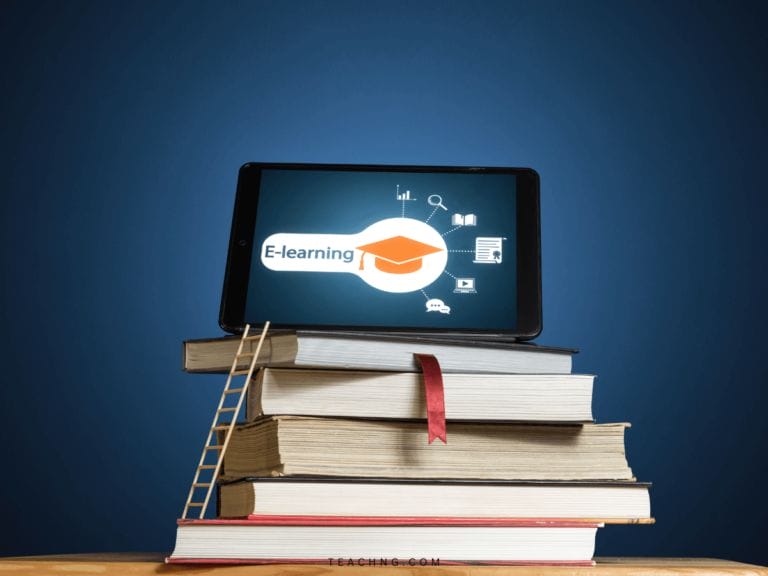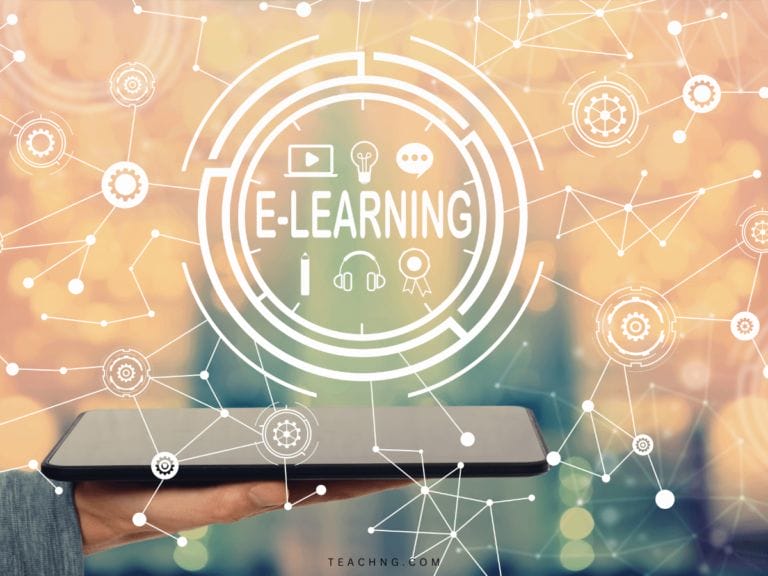Now, online learning is becoming the norm in education. More educators and teachers have used their creativity to create teaching strategies that give their pupils the best possible learning opportunities.
Among the various forms of virtual education, certain forms are more prevalent than others, including;
- Synchronous learning and asynchronous learning
- Computer-Assisted Learning (CAL) and Computer-Managed Learning (CML)
- Open-schedule learning and fixed-time learning
- Hybrid learning and interactive online learning
- Adaptive e-learning and linear e-learning
- Collaborative learning and individual learning
But since every person has a unique learning style, the approach that works best for one person might not work for another.

KEY TAKEAWAYS
- Online learning offers flexibility in scheduling and location, making education accessible to those with busy schedules or geographic constraints.
- Each online learning method has its advantages and disadvantages, such as real-time interaction in synchronous learning versus flexibility in asynchronous learning.
- Different online learning methods vary in cost, with some being more expensive due to technology requirements or instructor involvement.
- Adaptive e-learning stands out for its personalized approach, using AI to tailor coursework to individual learning styles, potentially making online education more effective.
Types of Online Learning in Education
The way we learn and learn new knowledge or skill is rapidly changing. Today, you can use online learning platforms to access a wide variety of online courses that are available on the internet. This change to online education has several benefits:
- Fresh approaches to education experience.
- Possibility of learning a new skill at any time.
- No geographical restriction on learning.
- Anyone can become an industry expert.
- Educators are offered a new way to make a living.
Attention Educators and Course Creators: Teachng offer educators the option to create and sell online courses for FREE ($0 capital invested). If you are an aspiring course creator, simply get started by becoming an instructor and start sharing your knowledge now.
With online learning becoming more and more popular, we will examine the many kinds of online learning and go over their benefits and drawbacks to help you choose the best kind of learning approach.
1. Synchronous Online Learning
Synchronous Online Learning involves real-time interaction between instructors and students over the internet, resembling a webinar format where participants engage through text, audio, or video chat simultaneously.
Pros of Synchronous Online Learning
- Enables real-time distance learning experiences.
- Combats social isolation often associated with long-distance education.
- Enhances instructor-student and student-student relationships.
- Facilitates rapid information dissemination while maintaining flexibility.
- Offers a structured learning environment with adaptability.
Cons of Synchronous Online Learning
- Typically comes with a higher cost.
- May not suit students with busy schedules.
- Interaction can feel less personal compared to traditional classrooms.
2. Asynchronous Online Learning
Asynchronous Online Learning occurs without real-time communication, with students accessing pre-recorded content and assignments on their own time. Interaction is facilitated through discussion boards, Wikis, and blogs, without set meeting times.
Pro of Asynchronous Online Learning
- Ideal for students with rigid schedules.
- Provides flexibility in scheduling.
- Encourages consistent engagement with instructors and peers.
- Often more cost-effective.
- Pre-recorded lessons allow for flexible review.
Cons of Asynchronous Online Learning
- May feel impersonal compared to in-class settings.
- Limited physical interaction with instructors and peers.
- Requires strong self-discipline from students.

3. Computer Assisted Learning (CAL)
Computer Assisted Learning, also referred to as Computer Based Learning, Computer Assisted Instruction, or Computer Managed Instruction, involves utilizing computers to support educational lessons, classes, or training.
While it’s not a new concept, it dates back to the 1960s with systems like PLATO (Programmed Logic for Automatic Teaching Operations).
Books on MP3s, cassettes, DVDs, and CDs all fall under the category of being a form of CAL. The versatility of this can encompass a range of educational subjects. Some of the most common ones are:
- Tutorials: These supplement an actual instructor and provide a solid outline for learning a course. This comes by way of slideshows, videos, smart device apps, and other media.
- Game-like Learning: By using fun interactivity similar to a video game, game-like learning incentivizes younger students to want to learn and master the material.
- Demonstrations: This involves the senses by incorporating auditory or visual data to immerse a student in a particular environment. Sometimes, this will use things like virtual reality or augmented reality.
- Practice: This form of learning online promotes mastery and memory recall. It’s the same as using flashcards, quizzes, or tasks in a hands-on learning environment.
Pros of Computer-Assisted Learning
- Simplifies the teaching of complex topics
- Provides immediate feedback
- Offers interactive and engaging learning experiences
- Tailored to individual student needs
- Abundance of opportunities for practice
Cons of Computer-Assisted Learning
- Can be costly to implement
- User and administrative challenges may arise
- Information can quickly become outdated
- Steep learning curve for users
- Risk of being more distracting than educational
- Potential over-reliance on technology by instructors and students
4. Computer-Managed Learning (CML)
Computer-Managed Learning involves assessing and administrating each student’s learning progress through databases.
Although it largely removes the instructor from the process, the instructor sets the parameters and conditions for student advancement.
CML proves beneficial for record-keeping, practice, and analyzing student strengths and weaknesses to develop better learning strategies.
Pros of Computer-Managed Learning (CML)
- Facilitates instructors in tracking student progress
- Efficient record-keeping of assignments and enrollment data
- Allows for repetition and practice to enhance information retention
- Analyzes student performance to improve learning strategies
- Offers continual monitoring of student progress
Cons of Computer-Managed Learning (CML)
- Impersonal and isolated learning approach
- Not suitable as a standalone method and requires supplementary learning forms
- Risk of over-reliance on technology by instructors
- Potential for boredom and disinterest among students due to monotony

5. Open Schedule Learning
Open Schedule Learning, often categorized under Asynchronous Online Learning, offers students a unique blend of freedom and structure. While students enjoy the flexibility to work at their own pace, they also benefit from supplementary resources like bulletin boards, regular emails, and online textbooks.
With this approach, students navigate a substantial workload and abundant information. Instructors set deadlines, fostering a self-paced learning environment that accommodates diverse learning styles and encourages leisurely material review.
Pros of Open Schedule Learning
- Ideal for self-directed learners.
- No fixed login times, offering flexibility.
- Affordable compared to other online learning formats.
Cons of Open Schedule Learning
- Requires discipline and self-motivation.
- Not suitable for those who thrive on social interaction.
- Can feel isolating for some students.
6. Fixed-Time Online Learning
Fixed-Time Online Learning mirrors traditional classroom settings, delivering pre-determined content to all students simultaneously. Unlike Open Schedule Learning, this format lacks adaptability to individual preferences, following a strict lesson plan enforced uniformly across all participants.
Similar to in-person classes, students log in at designated times, engaging in discussions, chats, and other interactive tools as prescribed by the instructor.
Pros of Fixed-Time Online Learning
- Beneficial for students lacking self-discipline.
- Provides immediate feedback from instructors.
- Replicates the classroom experience effectively.
Cons of Fixed-Time Online Learning
- Limited flexibility and adaptability.
- Less conducive to self-paced learning.
- Misses out on leveraging real-time student data for improvement.

7. Hybrid Online Learning
Hybrid Online Learning combines virtual and in-person classes, offering students a flexible and diverse learning experience. Through a blend of real classroom interaction and online resources, learners can engage with teachers face-to-face while accessing additional material online.
Here’s a breakdown of the different types of Hybrid Learning:
- Days In/Out: Students spend a portion of the week attending classes online and the rest in a physical classroom.
- In-Class Speaking/Out-of-Class Deadlines: Assignments and discussions happen in person, but submissions are made online.
- Online Speaking/In-Class Deadlines: Lectures are delivered online, but assessments are completed in person.
- Intermittency (Flex): Students alternate between online and in-person classes throughout the term.
Pros of Hybrid Online Learning
- Offers a tactile learning experience with real-time feedback.
- Provides scheduling flexibility while maintaining affordability.
- Allows for a blend of virtual and face-to-face interactions.
Cons of Hybrid Online Learning
- May pose challenges for some students.
- Potential for isolation if in-class time is limited.
- Not suitable for all learning styles.
8. Interactive Online Learning
Interactive Online Learning fosters direct communication between students and instructors through digital platforms like email or text chat. While less formal than traditional classrooms, it offers personalized support tailored to each learner’s needs.
Here’s a closer look at the pros and cons:
Pros of Interactive Online Learning
- Personalized instruction to suit individual abilities.
- Direct communication fosters a supportive learning environment.
- Minimizes distractions for focused learning.
Cons of Interactive Online Learning
- Limited access to traditional learning materials.
- Potential communication challenges due to text-based interactions.
9. Adaptive E-Learning
Embracing the forefront of online education, Adaptive E-Learning revolutionizes traditional teaching methods by tailoring content to individual students.
Leveraging artificial intelligence and augmented reality, this approach analyzes student performance and characteristics alongside the educator’s objectives.
Pros of Adaptive E-Learning
- Customizes coursework to suit diverse learning styles.
- Empowers instructors to identify and address patterns in student progress.
- Utilizes AI to dynamically adjust lessons, enhancing learning outcomes.
- Enhances the effectiveness and efficiency of online education.
Cons of Adaptive E-Learning
- Still undergoing developmental stages.
- Complexity in accommodating various learning styles can pose challenges.
10. Linear E-Learning
Linear E-Learning presents information in a one-way flow from instructor to student, devoid of interactive elements or submission requirements.
Common examples include televised or radio educational programs, offering flexibility in scheduling but lacking personalized student support.
Pros of Linear E-Learning
- Provides direct delivery of lectures and materials.
- Offers flexibility for self-paced learning.
Cons of Linear E-Learning
- Limited interactivity, offering minimal student engagement.
- Lack of teacher interaction and feedback.
- Reflects an outdated approach to online education.

11. Collaborative Online Learning
According to the University of Missouri, Collaborative Online Learning is a modern approach aimed at fostering student engagement and a sense of belonging within a group setting.
Students collaborate towards shared goals, honing their teamwork skills while receiving periodic feedback from instructors.
Pros of Collaborative Online Learning
- Fosters a sense of connection, reducing feelings of isolation common in other online learning formats.
- Cultivates teamwork skills essential for real-world success.
- Boosts confidence and expands knowledge through collective effort.
- Motivates students to achieve shared objectives.
Cons of Collaborative Online Learning
- Relies on group performance, potentially overshadowing individual contributions.
- Varied levels of participation among group members may lead to uneven workload distribution.
12. Individual Online Learning
Individual Online Learning extends the traditional classroom model, emphasizing personal learning goals over instructor-defined content. Students pursue self-directed study, tailoring their learning journey to meet their unique objectives.
Pros of Individual Online Learning
- Ideal for personalized exploration of niche or specialized subjects.
- Suited for students with strong self-discipline and autonomy.
- Empowers students to design their own curriculum based on individual needs.
Cons of Individual Online Learning
- Limited in its ability to support collaborative projects or group work.
- Offers minimal interaction with instructors, leading to potential feelings of isolation.

What Is Distance Learning?
Distance learning, also known as online learning or remote education an alternative to traditional, in-person classroom learning opportunities is offered while students and instructors are separated by physical distance.
All distance learning have the following characteristics:
| Aspects | Description |
|---|---|
| Flexibility | Allows students to study at their own pace and schedule, without being tied to a physical classroom. |
| Technology | Relies on digital tools such as video conferencing, online platforms, and email for communication. |
| Self-discipline | Requires self-motivation and organization to manage time effectively and stay on top of coursework. |
| Variety of Courses | Offers a wide range of courses and programs online, covering diverse subjects from academic to vocational fields. |
| Accessibility | Provides access to education for individuals unable to attend traditional classes due to various constraints. |
| Interaction | Facilitates interaction through discussion forums, virtual classrooms, and group projects. |
| Assessment | Involves assignments, quizzes, exams, and sometimes real-world projects to evaluate learning progress. |
Evolution of Online Learning For Future of Education
As technology is advancing, distance learning provides a flexible and accessible way to pursue education, catering to diverse learning styles and lifestyles. Emerging technology that enables distant learning includes:
- Increase accessibility of Learning Management System (LMS)
- Growth of online course platforms like Udemy, Teachng and Skillshare
- Introduction of better internet connection such as 5G Technologies
- Augmented Reality (AR), Virtual Reality (VR) & Simulations
- Emergence of Metaverse learning with full immersive learning experience
Today, instructors and learners can interact with each other through multiple channels such as; social media, email, video calls, forums and many other communication channels.
Simulating in-class experience virtually is no longer a dream but a reality.
How useful was this post?
Click on a star to rate it!
We are sorry that this post was not useful for you!
Let us improve this post!
Tell us how we can improve this post?





